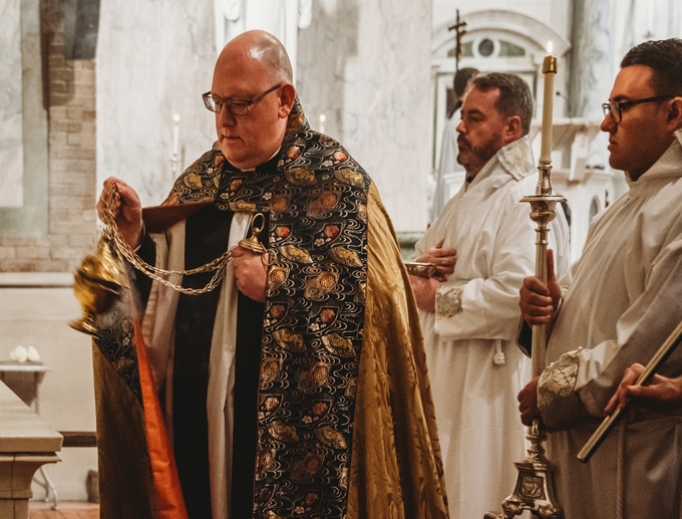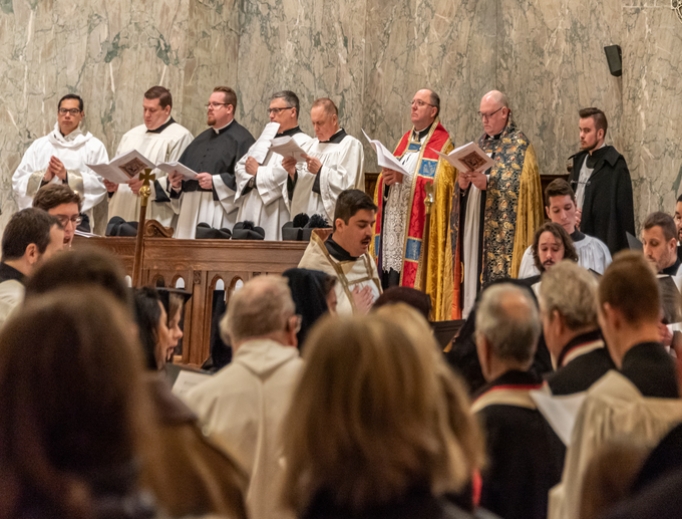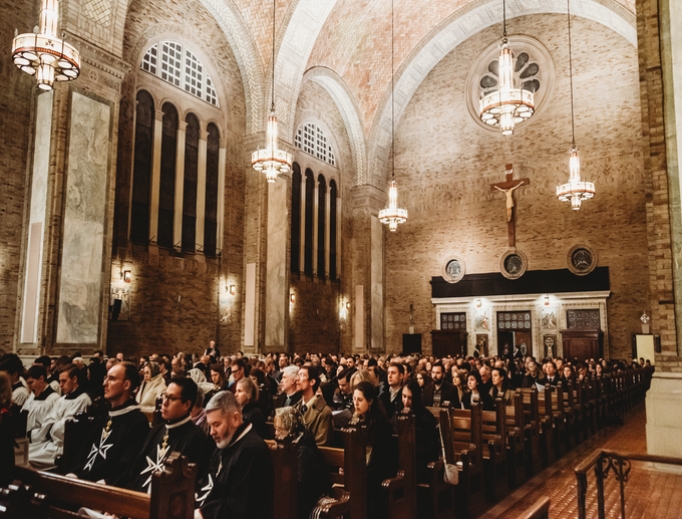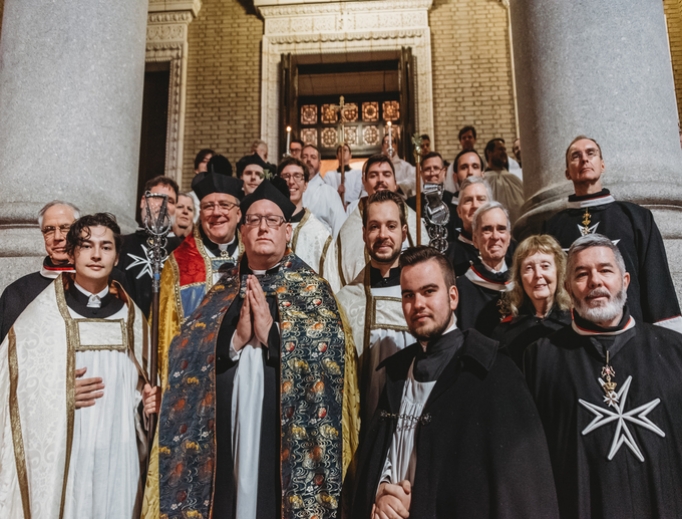From Earth to Heaven With England’s Glory: Sarum Vespers Resound in Philadelphia
Catholics prayed together in the Pre-Reformation English form of the Roman Rite familiar to St. Thomas More and his contemporaries.

PHILADELPHIA — Clouds upon clouds of incense wafted upon the marbled altars of St. Patrick’s Church in Philadelphia as priests in golden copes swung their thuribles, and choirs of men and women lifted the congregation with chants and songs of praise from the ancient heart of Catholic England. Enraptured by the sublime music of Sarum Vespers, as priests, clerics, acolytes and choirs performed their intricate roles within the majestic sanctuary, James Monti felt each of his senses completely engaged in the worship of God.
“It brought such peace and refreshment to the soul,” he told the Register. The tension of traffic jams and backups on the Benjamin Franklin Bridge he met on the way to St. Patrick’s on the long drive from New York had long melted away in the face of “one of the most beautiful liturgical rites I have ever been to.”
“I felt I was being transported back to the time of my favorite saint, St. Thomas More,” he said.
More than 700 Catholics packed St. Patrick’s Church on Feb. 1, the eve of the Feast of the Presentation (Candlemas), to pray together, for the first time in Philadelphia, Catholic Evening Prayer according to the Sarum Use: the form of the Liturgy of the Hours predominantly celebrated in England up to the Reformation. These forms of divine prayer and worship formed many English saints, mystics and martyrs, including St. Thomas More and Julian of Norwich.
James Thomas More Griffin, the lead organizer behind the Sarum Vespers at St. Patrick’s in Rittenhouse Square, told the Register the service was first and foremost a joyful celebration of the Liturgy of the Hours as the public prayer of the Catholic Church. He said people who attended were unanimous in praise, telling him they left “spiritually uplifted, renewed or rejuvenated.”
“They felt that the vespers took them from Earth to heaven,” he said. “And that’s exactly what I wanted those in the congregation to experience.”
Young people dominated the congregation, traveling from not only the environs of Philadelphia but from different states, as well. Griffin said he wanted the Sarum Vespers to evangelize students and scholars of music attending Philadelphia’s universities, allowing them to experience sacred music that they may have recited in a concert hall within its rightful Catholic context of prayer and worship.
Joining the congregation in the Dominican parish were members of the Knights of Malta, Knights of the Holy Sepulchre, Dominican friars, Norbertine canons, religious sisters, as well as priests, servers, and faithful from the Archdiocese of Philadelphia local Catholic dioceses, and the Ordinariate of the Chair of St. Peter, .a Catholic diocese with English Christian patrimony for North America founded by Pope Benedict in 2009.
“The real, the ultimate goal of any liturgy is the praise of Almighty God; and after that, the edification of the souls of those who are present,” Griffin said.
And the vespers has borne good fruit already.
“Two people approached me and asked how to enter into the Catholic Church after the event was over,” he said.




England’s Latin Mass and Divine Office
The Sarum Use is the English Church’s adaptation of the Roman Rite that had become by the reign of King Henry VIII the dominant form of the Mass and Liturgy of the Hours experienced by Catholics in England, Ireland and parts of Scotland. According to historians, Sarum Use originated with the Diocese of Salisbury (Sarum in Latin) shortly after the Norman Conquest of 1066. St. Osmond gave the Sarum liturgy its form by combining elements of Anglo-Saxon Catholic worship with the rites he knew from Normandy. Sarum remained the predominant liturgy of England up to the reign of Edward VI, with the publication of the 1549 Book of Common Prayer, itself an adaptation and translation of Sarum rites into sacral English for the separated Church of England.
“You can see how the spiritual life of St. Thomas More and his contemporaries would have thrived on the profound and heightened sense of sacrality that this liturgical rite produced,” James Monti said.
“I was amazed at the beauty of it all.”
The Sarum Vespers was truly a joint effort that brought together Catholics who worshipped and prayed typically in each of the three current forms of the Roman Rite: the ordinary, the extraordinary and the ordinariate forms of the Roman Rite, as well as experts in the forms of music and prayer proper to each.
Griffin, a Knight of Malta, instituted acolyte for the ordinariate and founder of a Gregorian men’s schola, was assisted in bringing the Sarum Vespers project to life by skilled experts, among them Nathan Knutson, director and chair of sacred music at St. Charles Borromeo Seminary; Father Robert Pasley, rector of Mater Ecclesiae Chapel, the first diocesan parish following Vatican II exclusively dedicated to the extraordinary form of the Latin Mass; and Peter Carter, director of sacred music at St. John the Baptist Church in Allentown, New Jersey.
Father Jason Catania, an ordinariate priest from St. Barnabas Catholic Church in Nebraska who was the officiant for Sarum Vespers, told the Register that the packed church was “certainly the largest congregation I’ve ever led for Evening Prayer.”
“And it was a very young crowd,” he said, noting the tremendous excitement people had for the beautiful service.
“Clearly there’s a desire among younger Catholics for traditional forms of the liturgy, whatever those particular forms may be,” he said.
Richness of English Patrimony
For the ordinariate, whose English Christian patrimony runs through the Anglican tradition to its pre-Reformation English Catholic roots, the Sarum Vespers provided a living glimpse into the liturgical roots of the Book of Common Prayer. For instance, the vespers service booklet noted that Sarum Vespers in Salisbury Cathedral was typically followed by the Little Office of the Virgin Mary or Compline.
Archbishop Thomas Cranmer later combined Sarum Vespers and Compline into a single service rendered in poetic English commonly called “Evensong,” which came into effect with the 1549 Book of Common Prayer. Evensong is today part of the ordinariate’s daily Office of the Liturgy of the Hours.
The Sarum Vespers has close similarities with the extraordinary form of the Roman Rite that had developed from the 1570 Roman Missal, such as five psalms with antiphons, but it has also distinguishing features. One of them is the presence of two priests incensing the altars of the Church. There is also a unique feature in Sarum Vespers and other medieval rites (that did not survive the Council of Trent’s liturgical reforms) called the “Responsory,” a sung meditation that responds to the scriptural reading just heard by all.
Griffin said organizing the event involved an “incredible amount of effort” to study the various documents on Sarum and consultations with various medieval experts to learn how to carry out the ceremonies effectively, with adaptations as needed for the needs of St. Patrick’s Church.
He explained that English parishes using the Sarum liturgy before the Reformation would have taken their cues from the cathedral ceremony of Salisbury and adapted it to their available resources.
“It was really up to parish priests to scale down the level of the ceremonial based on how many ministers they had available and the architecture of the church,” he said.
Reviving Ancient Beauty
The Sarum Use of the Mass and Divine Office have not enjoyed regular use since the reign of Mary I of England. These English rites escaped the suppression dealt many medieval rites in 1570 by St. Pius V with Quo Primum, which promulgated the Tridentine form of the Roman missal. However, when the English Catholic hierarchy was restored in the 19th century, the bishops opted to use the existing Roman Rite rather than return to Sarum.
Sarum liturgy and ceremonies have enjoyed some revived interest within the Anglican tradition. Father Catania noted that St. Barnabas, which had been an Episcopalian parish, had celebrated a few Sarum Masses before entering the ordinariate and becoming part of the Catholic Church.
Among Catholics in the United Kingdom, there have been a few recent celebrations of Sarum Use Masses and vespers since the 1990s. While no wide-scale revival is imminent, a Dec. 10, 2013, letter shown to the Register from Guido Pozzo, then secretary of the Pontifical Commission Ecclesia Dei, confirmed Sarum Use was “never formally abrogated” and that “any celebration of the liturgy according to the use of Sarum is to be carried out under the responsibility and supervision of the ordinary.”
Father Catania said the Sarum Vespers provide “a wonderful example of how the different local traditions that developed in the Church prior to the Reformation can speak to us today.”
“They reflect a richness that we all don’t have to be doing the same thing at the same time,” he said, “that there is a certain diversity in the unity of the faith, and an event like this reflects that.”
Valeria Lamarra, a Catholic from Alexandria, Virginia, who carpooled with friends to Philadelphia to join the congregation for Sarum Vespers, agreed.
“It brings back continuity between nations, between continents,” she said. As a church musician, she saw connections between aspects of Sarum plainchant and Byzantine chant. Lamarra said Sarum Vespers provided a visceral experience of how theologian Dietrich von Hildebrand described liturgy as a “continuously flowing river” and also had a royal majesty, with the verger (an escort armed with a long staff) and choir rulers in copes leading choristers and clerics in procession “making room for the King in a way.” Above all, she said the service had beauty and reverence.
“That’s going to bring people to God,” she said. “and that’s the bottom line.”
Medieval Life-Giving Liturgy
For medieval scholars like Griffin and Monti, the success of Sarum Vespers as a truly spiritual event confirmed how the study of the Church’s medieval patrimony is truly a potential source of spiritual revitalization for the Church today, and not solely the provenance of scholars.
“One of my hopes in describing and translating and documenting these medieval rites from different parts of Europe, like the Sarum Rite, was that by learning about these rites, seeing the people, reading about their beautiful ceremonies and prayers, the profound sense of the sacred these sacred ceremonies evince could be tapped into and drawn back into the current life of the Church,” Monti said.
The enthusiastic response and generosity of the collection from the vespers service, Griffin said, will allow for the possibility of more Sarum liturgies in the future. He and others have set up the Durandus Institute for Sacred Liturgy & Music, which he runs as executive director, to help offer more “great liturgical events that will offer worthy worship to God and will edify the faithful who attend.”
“The biggest takeaway was the study of medieval liturgy is not just a niche interest for myself or just a handful of like-minded people,” he said. “But it’s something that can truly benefit all of the faithful and enrich all Christians.”
Peter Jesserer Smith is a Register staff writer.
- Keywords:
- peter jesserer smith
- pre-reformation
- vespers

















